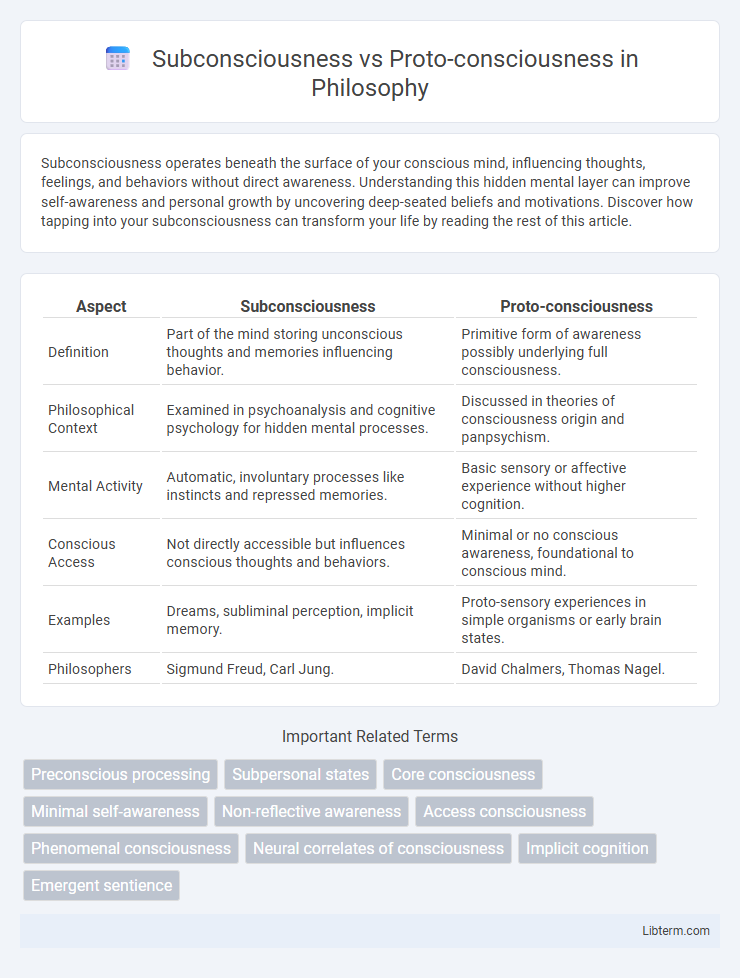Subconsciousness operates beneath the surface of your conscious mind, influencing thoughts, feelings, and behaviors without direct awareness. Understanding this hidden mental layer can improve self-awareness and personal growth by uncovering deep-seated beliefs and motivations. Discover how tapping into your subconsciousness can transform your life by reading the rest of this article.
Table of Comparison
| Aspect | Subconsciousness | Proto-consciousness |
|---|---|---|
| Definition | Part of the mind storing unconscious thoughts and memories influencing behavior. | Primitive form of awareness possibly underlying full consciousness. |
| Philosophical Context | Examined in psychoanalysis and cognitive psychology for hidden mental processes. | Discussed in theories of consciousness origin and panpsychism. |
| Mental Activity | Automatic, involuntary processes like instincts and repressed memories. | Basic sensory or affective experience without higher cognition. |
| Conscious Access | Not directly accessible but influences conscious thoughts and behaviors. | Minimal or no conscious awareness, foundational to conscious mind. |
| Examples | Dreams, subliminal perception, implicit memory. | Proto-sensory experiences in simple organisms or early brain states. |
| Philosophers | Sigmund Freud, Carl Jung. | David Chalmers, Thomas Nagel. |
Understanding Subconsciousness: Definition and Scope
Subconsciousness refers to the part of the mind that operates below conscious awareness, influencing thoughts, emotions, and behaviors without direct perception. It encompasses processes such as implicit memory, automatic skills, and repressed experiences, playing a crucial role in shaping decision-making and emotional responses. Understanding subconsciousness involves exploring neural mechanisms and psychological functions that govern how information is processed outside of conscious cognition.
Proto-consciousness Explained: Origins and Concepts
Proto-consciousness refers to a fundamental, primitive form of awareness believed to exist at the origins of consciousness, emerging during early developmental stages or in basic biological processes. It represents a pre-reflective state underlying the capacity for conscious experience, often described in theories linking it to neural or quantum activities. Research into proto-consciousness explores its role as a bridge between non-conscious matter and full-fledged consciousness, offering insights into the evolutionary and philosophical foundations of mind.
Key Differences Between Subconsciousness and Proto-consciousness
Subconsciousness refers to the part of the mind that operates below conscious awareness, influencing thoughts, behaviors, and emotions through stored memories and automatic processes. Proto-consciousness, by contrast, denotes a primitive or foundational form of awareness, often considered the earliest stage of consciousness present in basic life forms or pre-conscious states. The key differences lie in their complexity and function: subconsciousness involves dynamic cognitive processing without awareness, while proto-consciousness represents a minimal, emergent level of sentience or experiential capability.
Historical Perspectives on Conscious States
Historical perspectives on consciousness distinguish subconsciousness as the repository of inaccessible memories and processes, rooted in Freudian psychoanalytic theory, while proto-consciousness refers to a more primitive, incipient form of awareness suggested in early 20th-century philosophical and neuroscientific discussions. Freud's model emphasized subconscious processes influencing behavior without entering awareness, whereas proto-consciousness was proposed by thinkers like Thomas Nagel to describe minimal experiential states preceding full consciousness. These frameworks highlight evolving attempts to characterize varying depths and origins of conscious states in the history of psychology and cognitive science.
Neurobiological Foundations of Subconsciousness
Neurobiological foundations of subconsciousness involve brain regions such as the basal ganglia, amygdala, and thalamus, which facilitate information processing without conscious awareness. Subconsciousness operates through neural networks that manage automatic responses and implicit memory, distinct from proto-consciousness, which refers to a primitive form of awareness before full conscious perception. Research highlights the role of synchronized neural oscillations and neurotransmitter systems, including GABA and glutamate, in maintaining subconscious processing and enabling rapid, unconscious decision-making.
The Role of Proto-consciousness in Brain Development
Proto-consciousness plays a crucial role in brain development by providing a foundational non-local field of potential awareness that influences neural organization and the emergence of conscious experience. Unlike subconsciousness, which refers to hidden mental processes within the brain, proto-consciousness is considered a primordial state that interacts with developing neural networks to shape cognitive functions and sensory integration. Research in neuroscience and quantum biology suggests that proto-consciousness facilitates the synchronization of brain activity, promoting complex patterns of connectivity essential for higher-order consciousness.
Impact on Perception and Awareness
Subconsciousness processes information below conscious awareness, influencing perception by filtering sensory input and shaping implicit biases. Proto-consciousness, considered a more fundamental, pre-reflective state, provides the raw experiential substrate that underlies basic awareness before full cognitive interpretation occurs. The interaction between subconscious mechanisms and proto-conscious awareness significantly affects how stimuli are perceived and integrated into conscious experience.
Experimental Evidence: Measuring Conscious States
Experimental evidence comparing subconsciousness and proto-consciousness involves neuroimaging techniques like fMRI and EEG, which reveal distinct neural correlates for these states. Studies measuring brain activity during tasks such as subliminal perception and pre-conscious processing demonstrate that proto-conscious states exhibit more organized and sustained neural patterns than purely subconscious states. This empirical data supports the differentiation of proto-consciousness as a transitional conscious state with measurable cognitive and neural markers, distinct from the automatic, less coherent processes of subconsciousness.
Theories Connecting Subconsciousness and Proto-consciousness
Theories connecting subconsciousness and proto-consciousness explore the gradations between unconscious mental processes and primitive forms of awareness, suggesting subconsciousness acts as a reservoir of suppressed information influencing behavior, while proto-consciousness reflects a foundational, pre-reflective experiential state present in both humans and non-human entities. Integrated models propose that proto-consciousness underlies the emergence of subconscious mechanisms, offering a continuum from raw sensory processing to complex unconscious cognition. Neuroscientific research identifies brain regions like the thalamus and basal ganglia as crucial intersections where proto-conscious neural activity may transition into subconscious content storage and retrieval.
Implications for Future Consciousness Research
Exploring subconsciousness versus proto-consciousness reveals distinct layers of mental processing and primitive awareness that shape how researchers understand cognitive evolution. Subconsciousness involves automatic, non-aware mental functions, while proto-consciousness represents rudimentary experiential states suggesting the emergence of awareness. These insights guide future consciousness research toward integrating neural correlates of minimal awareness with complex subconscious processes to better map consciousness development across species.
Subconsciousness Infographic

 libterm.com
libterm.com